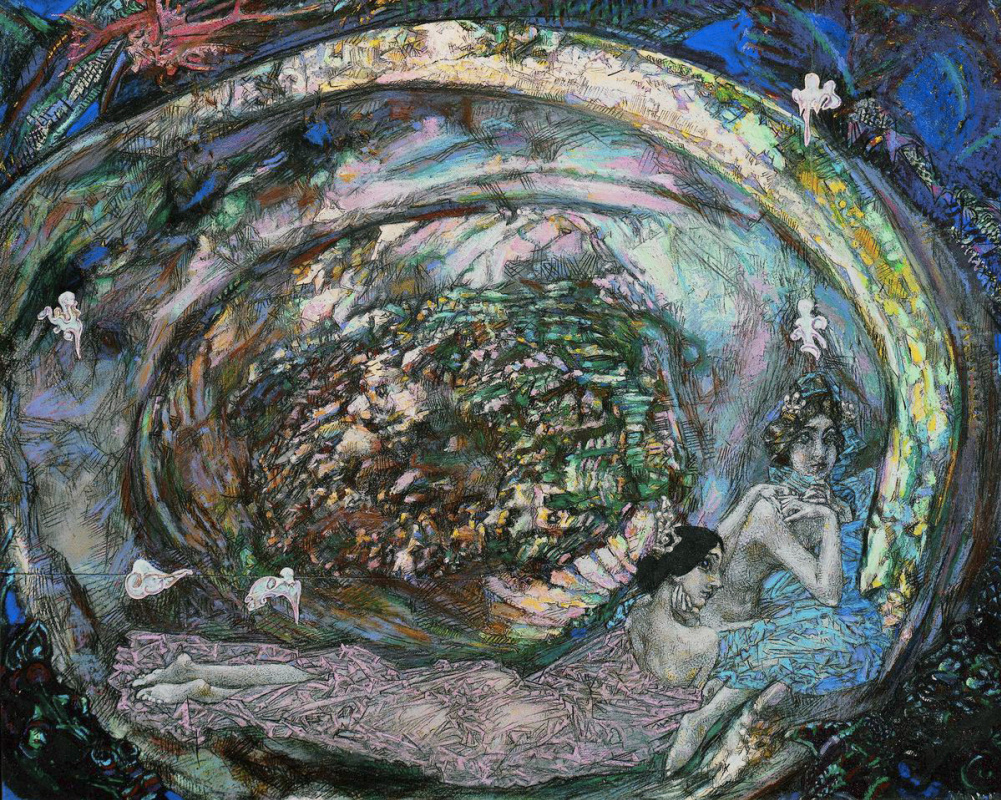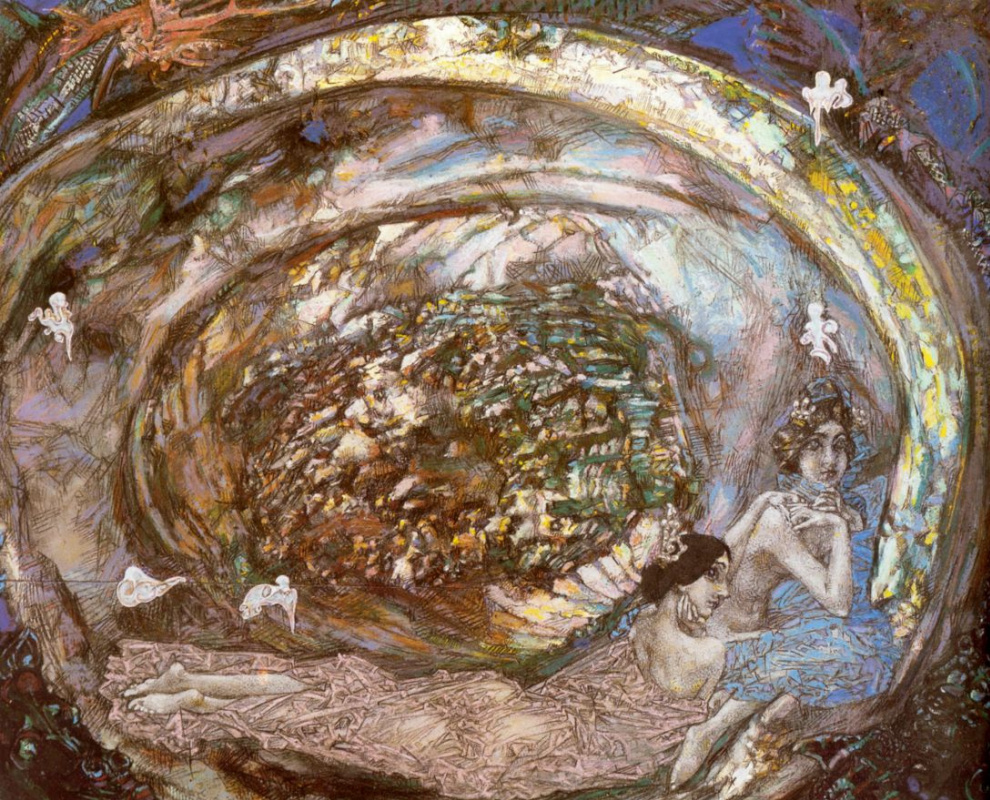log in
Enter site
Login to use Arthive functionality to the maximum
Pearl
Mikhail Aleksandrovich Vrubel • Peinture, 1904, 35×43.7 cm
Descriptif de la toile «Pearl»
The Pearl Seashell painting - One of Vrubel's last works, painted by him between bouts of mental illness that plagued him towards the end of his life. Beginning in 1902, he was treated for alternating episodes of mania and despondency in a psychiatric hospital, and this painting was created by him in a moment of brief remission.
Legend has it that the inspiration for the painting was a shell of pearl, given to the artist as a gift by Maximilian Voloshin. Vrubel sought a way to convey on canvas the iridescence of mother-of-pearl with paint, and he succeeded only after numerous attempts and sketches.
Fairytale characters appeared in the work after it was almost finished. The artist noted that this happened almost against his will: "After all, I did not intend to write sea princesses in his "Pearl", - he recalled. - I wanted to convey with all reality the drawing that makes up the play of mother-of-pearl shells, and it was only after making several drawings in charcoal and pencil that I saw these queens when I started painting with paints."
Vrubel was not satisfied with the image of mythical creatures in his picture. Critics did not appreciate them either. In particular, art historian Nina Dmitrieva noted: "The figurines he unexpectedly planted in the pearl shell are hardly worthy of such a magical grotto. These tomboyish figures are too reminiscent of their many long-haired sisters from typical Art Nouveau decor; the artist himself felt this vaguely - he was not happy with his naiads."
In spite of that, the artist more than succeeded in his task to embody on canvas the natural iridescence of pearl shell nacre. He managed it thanks to the use of many colors and shades: from the deepest tones of brown, green, blue and purple to the softest, almost transparent, pink, lilac and yellow. The spiral composition gives the image a hypnotic rhythm, drawing your attention deep into the picture like a whirlpool that carries a distracted swimmer to the seabed.
Nicholas Roerich shared his impressions of the painting in his essay: "Vrubel has not travelled much now; he has not seen much of anyone; he has turned away from everyday life and seen the beauty of life; he loved it and gave "The Pearl", the most precious one. An insignificant other wreck of nature tells him a wonderful tale of colours and lines beyond ''what'' and ''how''... More than ever in it Vrubel approached nature in the subtlest transfer of her and yet not removed from his usual magic."
The work was first shown at an exhibition of the Union of Russian Artists in 1905, and it is now part of the collection of the Tretyakov Gallery.
Author: Natalia Azarenko
Legend has it that the inspiration for the painting was a shell of pearl, given to the artist as a gift by Maximilian Voloshin. Vrubel sought a way to convey on canvas the iridescence of mother-of-pearl with paint, and he succeeded only after numerous attempts and sketches.
Fairytale characters appeared in the work after it was almost finished. The artist noted that this happened almost against his will: "After all, I did not intend to write sea princesses in his "Pearl", - he recalled. - I wanted to convey with all reality the drawing that makes up the play of mother-of-pearl shells, and it was only after making several drawings in charcoal and pencil that I saw these queens when I started painting with paints."
Vrubel was not satisfied with the image of mythical creatures in his picture. Critics did not appreciate them either. In particular, art historian Nina Dmitrieva noted: "The figurines he unexpectedly planted in the pearl shell are hardly worthy of such a magical grotto. These tomboyish figures are too reminiscent of their many long-haired sisters from typical Art Nouveau decor; the artist himself felt this vaguely - he was not happy with his naiads."
In spite of that, the artist more than succeeded in his task to embody on canvas the natural iridescence of pearl shell nacre. He managed it thanks to the use of many colors and shades: from the deepest tones of brown, green, blue and purple to the softest, almost transparent, pink, lilac and yellow. The spiral composition gives the image a hypnotic rhythm, drawing your attention deep into the picture like a whirlpool that carries a distracted swimmer to the seabed.
Nicholas Roerich shared his impressions of the painting in his essay: "Vrubel has not travelled much now; he has not seen much of anyone; he has turned away from everyday life and seen the beauty of life; he loved it and gave "The Pearl", the most precious one. An insignificant other wreck of nature tells him a wonderful tale of colours and lines beyond ''what'' and ''how''... More than ever in it Vrubel approached nature in the subtlest transfer of her and yet not removed from his usual magic."
The work was first shown at an exhibition of the Union of Russian Artists in 1905, and it is now part of the collection of the Tretyakov Gallery.
Author: Natalia Azarenko



